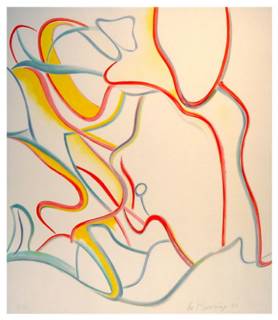Monday, December 27, 2004
De Kooning - Late Works 1


De Kooning 1976
De Kooning 1985
-The following are excerpts relating to the Late works of Willem De Kooning. Those works contrasting so much in style from ealier paintings that they have sparked various debates as to the authenticity of the work. De Kooning suffering from Alzheimers desease during the last ten years of life.
- de Kooning was very much helped by his former wife coming back to live with him during the last ten years of his life and during the onset of Alzheimer's.
She gave order to his day to day life and enabled him to carry on painting while still being able to maintain his memory of earlier works with the aid of constant reference to previous drawings. This may have caused him to rely more heavily on his former drawings and hence the more graphic and less painterly quality to his later work. He used transparencies of early drawings and sometimes laid them over the canvas in order to work directly from them. Elaine de Kooning was important in instructing assistants in the day to day practical matters of preparing canvases and making sure Willem was free to continue his art even through the increasingly difficult circumstances.
Stripping his paintings of the overtly abstract expressionist style reveals the structures that underly his work in more transparent way. However because art critics and collectors had invested heavily in the familiar emotional and expressive language of the earlier work, this work is somehow 'not de Kooning'. The facts are that the work is de Koonings, but de Kooning with Alzheimer's disease. This brings into the equation stereotypes labelled on people with disability and what that means in relation to their art output. De Kooning is one of the few well known artists to have developed a definite disability during his life. This gives us the unique situation where we can analyse the art worlds attitude to disabled artists.
The restriction in his ability to draw upon all of the complexity of skills that he had developed during a long life painting one could see as limiting the work and would accompany a deep sense of loss of a central character in the Abstract expressionist movement and the upsurge of American painting in the 40's and 50's. However I think that quite the opposite is true. The late change in emphasis in de Koonings' work has brought a founder member of the abstract expressionism to the fore again. This new and challenging work, apart from showing a different area of complexity to de Koonings' work, one which brings his work closer to artists such as Brice Marden and his old friend Philip Guston, again, as in the early agenda of abstract artists, deals with issues of conciousness and psychology but in an unexpected way. How conscious was de Kooning of what he was doing? Has that improved or lessened the 'greatness' of his art work or his identity as an artist? How much of creativity includes conscious thought? As in everything is in art the answers are always subjective. -